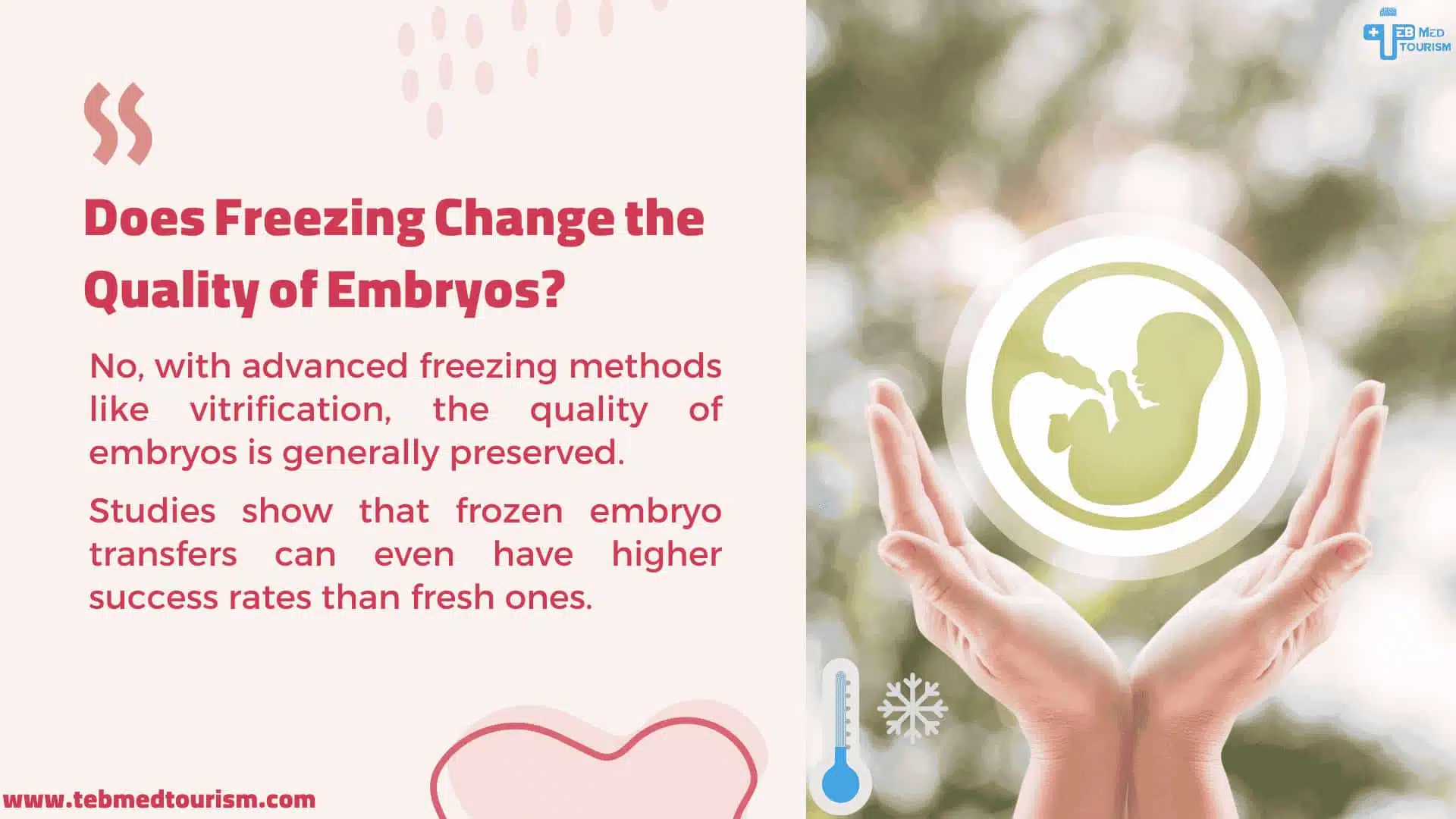

What Is Embryo Freezing?

Does Freezing Affect Embryo Quality?
Freezing embryos, eggs, and sperm is an essential component of assisted reproductive technologies (ART), offering flexibility and timing advantages for patients. However, its impact on the quality of these biological materials has been a subject of discussion. Many studies and clinical observations suggest that freezing embryos may have certain positive effects (3), although opinions on this matter can vary. When patients use their own eggs, freezing embryos instead of using fresh ones is often recommended. This approach gives the patient’s body—especially the uterus—time to recover after ovarian stimulation. This resting period can improve the chances of successful implantation and a healthy pregnancy. By allowing the uterine lining to return to a more natural state, frozen embryos may lead to higher success rates and enhanced success frozen quality compared to fresh ones in certain situations.
The situation differs when egg donation or surrogacy is involved. In these cases, fresh embryos are often preferred. This is because the fresh embryo transfer avoids the potential stress of freezing and thawing, which, while generally safe, can occasionally affect the biological integrity of the embryo. For egg donors and surrogates, synchronization between the donor’s egg retrieval and the surrogate’s cycle can allow for immediate transfer of fresh embryos, which may optimize the success rate.
It’s also critical to distinguish between freezing embryos, eggs, and sperm. Freezing embryos and sperm is generally considered to have minimal impact on their quality (4). Advances in cryopreservation methods, particularly vitrification (a rapid freezing technique), have greatly improved outcomes (5). However, freezing eggs is a different matter. Eggs are larger cells with a high water content, making them more sensitive to the freezing process. During freezing and thawing, the egg’s structure, including its chromosomes and outer shell (the zona pellucida), can be affected, potentially reducing its viability and success rate in treatments.
This distinction is important when considering the best approach for fertility treatments. Patients using their own eggs may benefit from freezing embryos to give their bodies time to optimize conditions for implantation. However, for egg donation or surrogacy, fresh embryo transfers are often a better choice, provided the timing between donor and recipient is well-coordinated.
In all cases, consulting with experienced fertility specialists is crucial to creating a tailored plan based on the patient’s unique needs and circumstances.At TebMedTourism, we provide expert guidance and personalized care to help you navigate your fertility journey. Contact us today for a free consultation, and let us support you every step of the way.
Additionally, if you’d like to learn more about the differences between fresh and frozen embryo transfer, be sure to check out our article “Fresh vs Frozen Embryo Transfer.”
Why Is It Important to Understand Its Effects?
Understanding the effects of freezing on embryos is crucial for individuals and couples navigating fertility treatments. This knowledge empowers patients to make informed decisions about their reproductive options, ensuring the best chance for a successful pregnancy while minimizing risks.
The freezing and thawing process, though highly advanced, can influence the viability and developmental potential of embryos. While modern cryopreservation techniques, such as vitrification, have significantly reduced the risk of cellular damage, subtle changes can still occur (6). These changes may impact the embryo’s ability to implant in the uterus or continue developing into a healthy pregnancy. Recognizing these potential effects, including factors related to success frozen quality, helps patients set realistic expectations and better understand the specific factors influencing their outcomes.
Moreover, understanding the science behind embryo freezing is essential for tailoring treatments to individual needs. For example, some patients may benefit more from frozen embryo transfers, especially if their uterine lining needs time to recover after ovarian stimulation. Others, such as those undergoing egg donation or surrogacy, might find fresh embryo transfers more advantageous. By understanding these details, patients and healthcare providers can work together to develop personalized strategies for achieving the best results.
Lastly, being aware of the effects of freezing contributes to better emotional and financial preparation. Fertility treatments can be stressful and expensive, and knowing how freezing may influence success rates helps patients plan for multiple cycles if needed. Clear communication between patients and their medical teams fosters trust and ensures that each decision is based on accurate, evidence-based information. This comprehensive understanding ultimately supports the goal of creating healthy families through assisted reproductive technologies.
Why Do People Freeze Embryos?
Around 10-12% of women undergoing IVF in recent years have chosen a “freeze-all” strategy, where all embryos are frozen and transferred at a later time. This statistic highlights the growing popularity of embryo freezing as a flexible and effective option in fertility treatments. But what motivates individuals and couples to choose this approach?
Embryo freezing is a valuable tool in reproductive medicine, and the reasons for choosing this option can vary from person to person. Whether for medical, personal, or logistical reasons, it offers flexibility and reassurance for the future. Below, we will discuss a few of the most common reasons why people decide to freeze their embryos.
A) Flexibility in Family Planning
Embryo freezing allows individuals and couples to postpone pregnancy until they are ready. Whether due to career goals, personal circumstances, or financial considerations, freezing embryos provides the option to have a child at a later, more convenient time without compromising the biological potential of the embryos.
B) Making the Most of IVF Cycles
During IVF, multiple embryos are often created in a single cycle. Instead of discarding the unused embryos, freezing allows them to be preserved for future attempts. This minimizes the need for repeated ovarian stimulation and egg retrieval, saving time, effort, and cost while reducing physical and emotional strain.
C) Preserving Fertility Before Medical Treatments
For individuals facing treatments like chemotherapy or radiation that may harm fertility, embryo freezing is a proactive step. By preserving embryos beforehand, patients maintain their ability to have biological children once their treatment is complete and their health is restored.
D) Planning for Uncertain Futures
Some individuals freeze embryos to prepare for unpredictable circumstances, such as deployment in the military or health concerns that could arise later. This ensures that they have preserved their reproductive options, offering peace of mind in the face of future uncertainties.
Benefits of Frozen Embryos
Frozen embryos have become a cornerstone of modern fertility treatments, offering a range of advantages for individuals and couples seeking to build their families. By preserving embryos through advanced cryopreservation techniques, patients gain unique benefits that enhance the overall success and convenience of their reproductive journey. Below, we explore the key benefits of frozen embryos.
1. Cost-Effectiveness
Frozen embryo transfer (FET) can be more cost-effective compared to starting a new IVF cycle. Once embryos are frozen, patients avoid the need for ovarian stimulation and egg retrieval in subsequent attempts, which are among the most expensive parts of IVF. This allows patients to save money while still maintaining a high chance of achieving pregnancy.
2. Flexibility in Timing
Frozen embryos provide the flexibility to delay pregnancy until the timing is ideal. Whether due to personal, medical, or professional reasons, patients can choose to postpone embryo transfer without compromising the quality of the embryos. This option is especially beneficial for those undergoing medical treatments or those who want to plan their family around major life events.
3. Age Advantage
Freezing embryos at a younger age preserves their quality for future use. This is particularly valuable, as egg quality naturally declines with age. By freezing embryos earlier, patients can use their younger, healthier embryos even if they attempt pregnancy years later, effectively counteracting the impact of advancing age on fertility.
4. Reduced Stress
For many patients, freezing embryos removes the pressure of immediate decision-making during an IVF cycle. It allows them to take time to recover physically and emotionally after ovarian stimulation, creating a more relaxed and supportive environment for a successful transfer. Additionally, knowing that embryos are preserved provides peace of mind and a sense of security.
Conclusion: Does the Quality of Embryo Change by Freezing?
The role of cryopreservation in modern fertility treatments has been transformative. Based on extensive research and clinical observations, the answer to whether freezing affects embryo quality is both nuanced and reassuring.
While the freezing and thawing processes may pose minimal risks to the biological integrity of embryos, advancements in cryopreservation techniques, particularly vitrification, have significantly reduced these risks.
Ultimately, the evidence shows that modern cryopreservation techniques, such as vitrification, have made freezing a reliable option, maintaining embryo quality while offering significant benefits for patients.
As a result, the overall quality and viability of frozen embryos are generally maintained, with many studies suggesting comparable, if not superior, success rates for frozen embryo transfers (FETs) compared to fresh transfers.
It is important to note that the impact of freezing depends on factors such as the initial quality of the embryos, the patient’s medical history, and the expertise of the fertility clinic. In cases where the uterine environment requires recovery after ovarian stimulation, freezing embryos provides an opportunity to optimize implantation conditions, further enhancing pregnancy outcomes.
In conclusion, freezing embryos is a safe and effective option that has transformed fertility treatments, offering flexibility and improved success rates for many patients. By consulting with experienced fertility specialists and understanding the nuances of this process, individuals can confidently incorporate embryo freezing into their fertility journey, knowing that its benefits far outweigh its minimal risks. With the right approach and advanced technologies, frozen embryos remain a powerful tool for creating healthy families.









